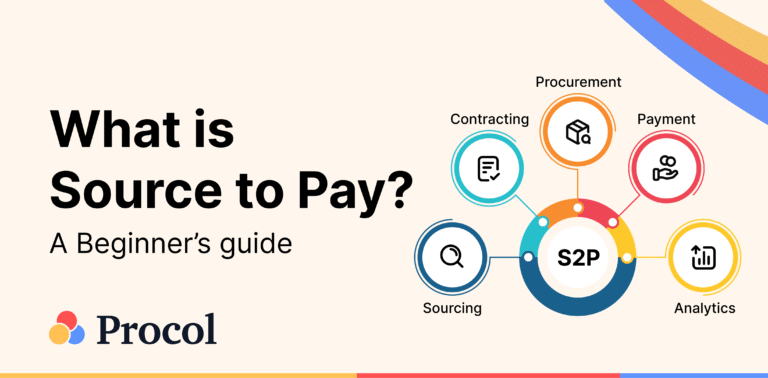Procol • February 24, 2025
Sustainable Procurement: The Strategy, Aspects, and Implementation of It All

Introduction
Procurement is important to business success, especially for manufacturing, construction, logistics and transportation, retail, and e-commerce businesses. Because of its benefits, sustainable procurement is gaining popularity. It has been estimated that by 2025, the market for sustainable procurement will be worth $6.7 trillion. But why is it becoming a popular practice?
Most businesses desire an increased reputation for their brand in the market. Companies incorporating sustainable procurement have experienced improvement by 55% in their reputation and brand. Sustainable procurement achieves cost reduction without any negative impact on the business. By 2025, procurement expenses can be reduced by 20% through digital tools in sustainability.
Sustainable procurement is the process of purchasing goods or services considering their economic, environmental, and social impacts. It promotes positive social impact and lowers harmful impact while ensuring that the goods or services continue to fulfill the needs of the stakeholders
What is a sustainable procurement strategy?
A procurement strategy created by ensuring that procurement will have a positive environmental, economic, and social impact is a sustainable procurement strategy. It’s developed to provide direction in successfully implementing a sustainable procurement process. The procurement department, corporate social responsibility team, finance department, legal and compliance team, and senior management team play a significant role in successfully implementing a sustainable procurement strategy.
Important factors to be considered while implementing a sustainable procurement strategy:
- Objectives: Define a clear purpose and goals the organization wants to achieve with a sustainable procurement strategy.
- Policy creation: Outline policy around sustainable procurement; it includes guidelines and various criteria.
- Involving stakeholders: Involve internal and external stakeholders to meet sustainability requirements.
- Management of suppliers: Create a list for selecting suppliers, considering whether they align with your objectives and vision. It’s important to evaluate suppliers’ work for improvement.
- Procurement processes: Selectively purchasing products considering their environmental, social, and economic impact. Predefining total cost of ownership.
- Performance measurement and reporting: Using essential procurement KPIs to measure the success of an effective procurement process and monitoring and analyzing its report.
Three aspects of sustainable procurement strategy
Economic viability
Implementing a procurement process that considers its environmental, social, and economic impact is the main aspect of a sustainable procurement strategy. Still, considering its profitable financial aspect, it’s also being taken care of. It involves evaluating the financial stability of suppliers and other financial factors that support the economy’s growth.
It’s cost-effective as it avoids future unnecessary expenses such as replacement costs, energy costs, etc., and lowers the possibility of supply chain interruptions when purchasing from suppliers who practice sustainability. Products’ sustainable nature gives them a competitive advantage in the market. As demand for sustainable products increases, it can lead to a spike in sales, which overall contributes to economic viability.
Social accountability
Social accountability is the company’s responsibility, which includes applying ethical practices, specifically in supply chain processes, to create a positive impact on society. It includes selecting suppliers engaging in fair labor practices, preserving human rights, helping local communities by procuring from them and selecting suppliers involved in sustainable practices.
Reputation is a company’s top priority, so dealing with suppliers who share social responsibility values becomes necessary. Commitment to social accountability promotes brand loyalty.
Environmental stewardship
It focuses on reducing harmful negative impacts on society throughout the supply chain. It involves using recycled eco-friendly products, emitting less carbon, and creating less environmental impact. Selecting local suppliers and energy-efficient products to reduce carbon footprint.
Ensure waste management using reused or recycled material and follow all applicable environmental laws. Environmental stewardship gives an advantage in cost savings, long-term savings benefits, enhancing company reputation in the market, and overall usefulness in achieving sustainability goals.
How to implement a sustainable procurement strategy?
1. Make a definite sustainability policy
Defining a definite sustainability policy that will be useful in achieving a company’s sustainable practices objective, considering its environmental impact, becomes a primary task to successfully implement a sustainable procurement strategy. Sustainability policy must include a long-term vision, define the company’s objective for choosing sustainable procurement, and establish time frames to measure progress.
Be clear about which type of product or services the policy covers, create guidelines for selecting the required material, and have criteria for choosing suppliers practicing sustainable practices. The most important thing is to outline the responsibility of stakeholders in the entire procurement journey.
2. Analyze the procurement procedures you now use
Analyzing the procurement process currently being followed by the company is crucial to identifying loopholes and areas for improvement to help the business achieve its objective. Analyzing includes evaluating suppliers to determine whether they align with your vision, examining data regarding the impact of products, etc. Have clear Key performance indicators (KPIs) to measure the effect and impact of sustainable procurement practices.
Understand what your current sustainable procurement strategy lacks in comparison to the best practices industry and list what can be done to achieve desired sustainability goals.
3. Interact with vendors
The supplier has a significant role to play in the procurement process; therefore, it becomes extremely important to establish clear communication with suppliers, which is a great way to ensure alignment with the company’s objective. Outlines the standards suppliers must meet, emphasizes more on building long-term relationships, encourages suppliers to maintain transparency, and incorporates sustainable practices only.
Educate your vendors on best sustainable practices and ways to improve. Get feedback from them, conduct their audits, and use KPIs to measure the effectiveness of suppliers’ sustainable practices.
4. Consider including sustainability in procurement procedures
After clearly defining sustainability policy and analyzing previous sustainable procurement practices, the most important step is to include sustainability in procurement procedures. Define procurement specifications, evaluate life cycle assessment, collaborate with a supplier who sincerely follows sustainable practices, and collectively work with them to improve.
Conduct regular audits, which can help identify improvement areas. Define metrics to evaluate the success of implementing a sustainable procurement strategy.
5. Track, evaluate, and report developments
Tracking, evaluating, and reporting become essential to measuring the effectiveness of sustainable procurement strategy. Few ways exist to effectively carry out this process:
a. KPIs – Various factors can be measured, such as carbon emission rate and supplier diversity, and defining KPIs to measure progress is a great way to identify progress.
b. Data analysis – Analyze collected data and identify which needs to be improved.
c. Implement tracking systems – Integrating procurement software tools and monitoring them is an effective way.
Examples of sustainable procurement
- Transportation and logistics: Ensuring the use of fuel-efficient vehicles while selecting logistics and the use of electric vehicles in companies’ work is a way to achieve sustainable procurement.
- Office supplies and equipment: Using electronics with Energy Star certification, furniture can be made from reused materials and materials with fewer toxic chemicals.
- Programs for waste reduction: Include suppliers in activities that focus on cutting waste through the supply chain.
- Fairtrade products: To ensure fair labor costs and pay for producers, purchasing material certified by Fair Trade is a way to sustainable procurement.
Companies such as IKEA, IBM, Unilever, and Patagonia have incorporated sustainable procurement into their businesses, which positively contributes to the environment and increases profitability.
KPIs of sustainable procurement
Environmental impact
1. Percentage of green purchases: The percentage of green purchases out of total purchases that meet the sustainability criteria is the percentage of green purchases.
It can be calculated as (Green Purchase Value / Total Purchase Value) x 100
2. Carbon emissions per unit of purchase: The average amount of carbon emissions is calculated using Carbon Emissions per Unit of Purchase for every unit of product or service procured.
It can be calculated as: Total carbon emissions / Total units purchased.
3. Waste reduction: It is an important KPI to calculate the amount of waste generated and effectively reduced.
4. Water usage reduction: Reduction in water consumption with effective water management through water-efficient products or services is measured using Water Usage Reduction.
It can be calculated as:
Water Usage Reduction(%) = ( Baseline Water Usage − Current Water Usage / Baseline Water Usage ) ×100
Social responsibility KPIs
1. Supplier diversity: Supplier Diversity measures a company’s capacity and success in dealing with various suppliers.
2. Fair labor practices: This KPI measures the degree to which suppliers follow established laws and labor guidelines.
3. Community impact: Monitoring this KPI ensures the company’s practices align with social responsibility. Community Impact measures the effect of procurement practices on local communities, whether positive or negative.
4. Supplier code of conduct compliance: Supplier Code of Conduct Compliance KPI is effective in measuring the extent to which suppliers align with the code of conduct related to social, ethical, and environmental standards created by business
Supplier code of conduct compliance = ( Number of Suppliers in Compliance / Total Number of Suppliers )×100%
Economic viability KPI
1. Total cost of ownership (TCO): This KPI doesn’t merely calculate purchase cost; the total cost of ownership is the summation of initial purchase cost, operating costs, maintenance costs, disposal costs, and other relevant costs through its entire lifecycle.
2. Return on Investment (ROI): As the name suggests, this KPI effectively calculates the monetary benefits derived from investments in procurement practices. From the high ROI, it can be stated that sustainable procurement practices are effective and efficient. It’s useful in making future data-driven decisions.
It can be calculated as:
ROI= (Net Financial Benefit / Total Cost of Sustainable Procurement Initiatives)×100
3. Supplier performance index: Companies have some predefined criteria and standards, and this KPI helps understand how well the supplier meets those criteria. The high supplier performance index defines a supplier as good at his work and meeting sustainability goals and objectives.
How can Procol help you with procurement?
Using e-procurement software improves the procurement process. Procol is your ideal e-procurement software, providing user-friendly software and various features like insightful reports, real-time data, and more, ultimately ensuring your business’s success.
E-procurement software streamlines procurement processes and promotes overall business growth. Strategic sourcing is one of the major benefits that can be calculated using strategic sourcing KPIs. Similarly, inventory optimization, increased productivity, improved accuracy, cost savings, time savings, reduced unauthorized spending, and competitive edge are other highlighting benefits of utilizing e-procurement software.
Conclusion
Sustainable procurement is gaining traction due to the various benefits it offers. It enhances the company’s reputation through long-term cost reduction, which helps in achieving economic, environmental, and social objectives regarding sustainability procurement strategy. Economic viability, environmental stewardship, and social accountability are three pillars of sustainable procurement, which are essential in effectively implementing a sustainable procurement strategy.
Outlining a definite sustainability policy, analyzing the current procurement process, communicating with suppliers, executing a sustainability procurement procedure, and tracking and evaluating various measures are five crucial steps in successfully implementing a sustainability procurement strategy. KPIs around environmental impact, social responsibility, and economic viability have been mentioned to define the success of a sustainability procurement strategy.
Explore more from Procol
Discover expert tips, how-to guides, industry insights, and the latest procurement trends.

Best eSourcing Tools: Top 10 eSourcing Software in 2025
Discover top 10 e-sourcing tools and esourcing platforms necessary for efficient...

What is Source-to-pay in 2025? An Ultimate Guide
Source to pay is the process of sourcing vendors to procure...

End-to-End Guide to What is Procurement Contract Management?
Wondering what is procurement contract management, then this end-to-end guide explains...









